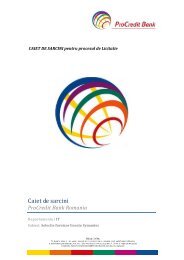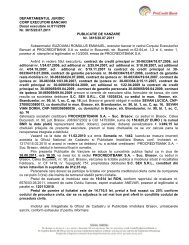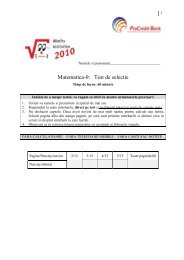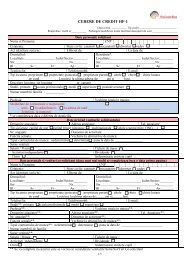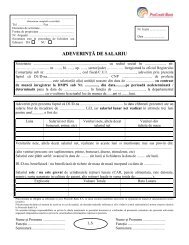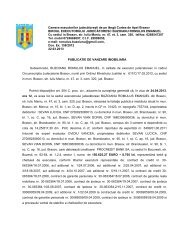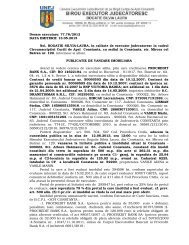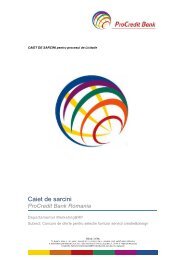Annual Report 2010 - ProCredit Bank
Annual Report 2010 - ProCredit Bank
Annual Report 2010 - ProCredit Bank
Create successful ePaper yourself
Turn your PDF publications into a flip-book with our unique Google optimized e-Paper software.
56<br />
<strong>Annual</strong> <strong>Report</strong> <strong>2010</strong><br />
carrying amount that would have been determined, net of depreciation<br />
or amortisation, if no impairment loss had been recognised.<br />
m) Deposits and subordinated liabilities<br />
Deposits and subordinated liabilities are the <strong>Bank</strong>’s sources of<br />
debt funding. The <strong>Bank</strong> classifies capital instruments as financial<br />
liabilities or equity instruments in accordance with the substance<br />
of the contractual terms of the instrument.<br />
Deposits and subordinated liabilities are initially measured at fair<br />
value plus transaction costs, and subsequently measured at their<br />
amortised cost using the effective interest method.<br />
n) Provisions<br />
A provision is recognised if, as a result of a past event, the <strong>Bank</strong><br />
has a present legal or constructive obligation that can be estimated<br />
reliably, and it is probable that an outflow of economic benefits will<br />
be required to settle the obligation. Provisions are determined by<br />
discounting the expected future cash flows at a pre-tax rate that reflects<br />
current market assessments of the time value of money and,<br />
where appropriate, the risks specific to the liability.<br />
o) Financial guarantees<br />
Financial guarantees are contracts that require the <strong>Bank</strong> to make<br />
specified payments to reimburse the holder for a loss it incurs because<br />
a specified debtor fails to make payment when due in accordance<br />
with the terms of a debt instrument.<br />
Financial guarantee liabilities are initially recognised at their fair<br />
value, and the initial fair value is amortised over the life of the financial<br />
guarantee. The guarantee liability is subsequently carried at the<br />
higher of this amortised amount and the present value of any expected<br />
payment (when a payment under the guarantee has become<br />
probable). Financial guarantees are included within other liabilities.<br />
The <strong>Bank</strong> has no financial guarantees as at 31 December <strong>2010</strong>.<br />
p) Employee benefits<br />
iv. Short-term benefits<br />
Short-term employee benefit obligations are measured on an<br />
undiscounted basis and are expensed as the related service is<br />
provided.<br />
Short-term employee benefits include wages, salaries, bonuses<br />
and social security contributions. Short-term employee benefits<br />
are recognised as expense when services are rendered. A provision<br />
is recognised for the amount expected to be paid under short-term<br />
cash bonus or profit-sharing plans if the <strong>Bank</strong> has a present legal or<br />
constructive obligation to pay this amount as a result of past service<br />
provided by the employee and the obligation can be estimated<br />
reliably.<br />
v. Defined contribution plans<br />
Obligations for contributions to defined contribution pension plans<br />
are recognised as an expense in profit or loss when they are due.<br />
The <strong>Bank</strong>, in the normal course of business makes payments to the<br />
Romanian State funds on behalf of its Romanian employees for pension,<br />
health care and unemployment benefit.<br />
All employees of the <strong>Bank</strong> are members and are also legally obliged<br />
to make defined contributions (included in the social security contributions)<br />
to the Romanian State pension plan (a State defined<br />
contribution plan). All relevant contributions to the Romanian State<br />
pension plan are recognised as an expense in the income state-<br />
ment as incurred. The <strong>Bank</strong> does not have any further obligations.<br />
The <strong>Bank</strong> does not operate any independent pension scheme and,<br />
consequently, has no obligation in respect of pensions.<br />
vi. Defined benefit plans<br />
The <strong>Bank</strong> does not operate any defined benefit plan, thus has no<br />
obligation related to contributions to any such plan.<br />
i. Other long-term employee benefits<br />
The <strong>Bank</strong>’s net obligation in respect of long-term employee benefits<br />
other than pension plans is the amount of future benefit that<br />
employees have earned in return for their service in the current and<br />
prior periods. The <strong>Bank</strong> has no contractual obligation to pay any<br />
long-term benefit calculated taking into account the past service.<br />
ii. Termination benefits<br />
The <strong>Bank</strong> is not committed, without realistic possibility of withdrawal,<br />
to any formal detailed plan to terminate employment before<br />
the normal retirement date.<br />
q) Standards and interpretations not yet adopted<br />
A number of standards, amendments to standards and interpretations<br />
are not yet effective for the year ended 31 December <strong>2010</strong>,<br />
and have not been applied in preparing these consolidated financial<br />
statements. None of these will have an impact on the financial<br />
statements of the <strong>Bank</strong>, with the exception of:<br />
• IFRS 9, “Financial Instruments” (effective for annual periods<br />
beginning on or after 1 January 2013, early adoption is permitted)<br />
is not yet effective for the year ended 31 December<br />
<strong>2010</strong>, and has not been applied in preparing these financial<br />
statements. This Standard replaces the guidance in IAS 39,<br />
Financial Instruments: Recognition and Measurement, about<br />
classification and measurement of financial assets and liabilities,<br />
and derecognition of financial assets and liabilities. The<br />
Standard eliminates the existing IAS 39 categories of held to<br />
maturity, available for sale and loans and receivable. Financial<br />
assets will be classified into one of two categories on initial<br />
recognition: financial assets measured at amortised cost; or<br />
financial assets measured at fair value. A financial asset is<br />
measured at amortised cost if the following two conditions are<br />
met: the assets are held within a business model whose objective<br />
is to hold assets in order to collect contractual cash flows;<br />
and, its contractual terms give rise on specified dates to cash<br />
flows that are solely payments of principal and interest on the<br />
principal outstanding. Gains and losses on re-measurement of<br />
financial assets measured at fair value are recognised in profit<br />
or loss, except that for an investment in an equity instrument<br />
which is not held for trading, IFRS 9 provides, on initial recognition,<br />
an irrevocable election to present all fair value changes<br />
from the investment in other comprehensive income (OCI). The<br />
election is available on an individual share-by-share basis. No<br />
amount recognised in OCI is ever reclassified to profit or loss at<br />
a later date. It also includes those paragraphs of IAS 39 dealing<br />
with how to measure fair value and accounting for derivatives<br />
embedded in a contract that contains a host that is not a financial<br />
asset, as well as the requirements of IFRIC 9, “Reassessment<br />
of Embedded Derivatives”. It is expected that the new<br />
Standard, when initially applied, will have a significant impact<br />
on the financial statements, since it will be required to be retrospectively<br />
applied. However, the <strong>Bank</strong> is not able to prepare<br />
an analysis of the impact this will have on the financial statements<br />
until the date of initial application. The <strong>Bank</strong> has not yet<br />
decided on the date that it will initially apply the new Standard.<br />
This standard has not been endorsed by the European Union.




